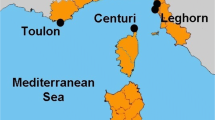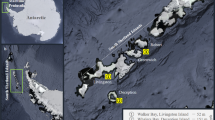Abstract
The most abundant marine fungi encountered in various regions of the Sea of Japan belong to the generaPenicillium, Aspergillus, Wardomyces, Trichoderma, Chrysosporium, andChaetomium. Facultative marine fungi of the generaScytalidium, Verticillium, andOidiodendron and obligate marine fungi of the genusDendryphiella are much less abundant. The composition of marine sediments and the anthropogenic load on them were found to influence the abundance and species diversity of fungi, as well as the occurrence of fungal strains producing hemolytically active substances. The biodiversity of mycobiota and the abundance of hemotoxin-producing fungi in marine sediments may be used to evaluate the anthropogenic load on marine biocenoses. Hemolytic compounds were produced by 57% of the fungi isolated from marine sediments. The hemolytic activity ofChaetomium spiculipilium was revealed in the fraction of the culture liquid containing extracellular fatty acids and pigments. The fatty acid composition of this marine fungus was determined.
Similar content being viewed by others
References
Steele, S.W., Fungus Populations in Marine Waters and Coastal Sands of the Hawaiian, Line, and Phoenix Islands,Pacific Science, 1967, vol. 21, pp. 317–331.
Sparrow, F. K., Jr., The Occurrence of Saprophytic Fungi in Marine Muds,Biol. Bull., 1937, vol. 73, pp. 242–248.
Hugnes, G.C.,Intertidal Lignicolous Fungi from Newfoundland, Can. J. Botany, 1968, vol. 46, pp. 1409–1417.
Artemchuk, N.Ya.,Mikroflora morei SSSR (Marine Microflora of the USSR), Moscow: Nauka, 1981.
Liberra, K. and Lindeauist, U., Marine Fungi, a Prolific Resource of Biologically Active Natural Products?,Pharmazie, 1995, vol. 50, pp. 583–588.
Kakeya, H., Takahashi, I., Okada, G., Isono, K., and Osada, H., Epolactaene, a Novel Neuritogenic Compound in Human Neuroblastoma Cells, Produced by a Marine Fungus,J. Antibiot., 1995, vol. 48, no. 7, pp. 733–735.
Onuki, H., Miyashige, H., Hasegawa, H., and Yamashita, Sh., NII5501A, a Novel Anthranilamide Derivative from a Marine FungusPenicillium sp.,J. Antibiot., 1998, vol. 51, no. 4, pp. 442–444.
Litvinov, M.A. and Dudka, I.A.,Metody issledovaniya mikroskopicheskikh gribov presnykh i solenykh (morskikh) vodoemov (Methods for Investigation of the Microscopic Fungi of Freshwater Bodies and Seas), Leningrad: Nauka, 1975.
Bilai, V.I.,Metody experimental’noi mikologii. Spravochnik (Experimental Methods in Mycology: A Guide), Kiev: Naukova Dumka, 1982.
Megarran, E.,Ekologicheskoe raznoobrazie i ego izmerenie (Ecological Diversity and Its Evaluation), Moscow: Mir, 1992.
Urbakh, V.Yu.,Biometricheskie metody (Biometric Methods), Moscow: Nauka, 1964, pp. 182–185, 386–91.
Kalinin, V.I., Prokofieva, N.G., Likhatskaya, G.N., Schensova, E.B., Agafonova, I.G., Avilov, O.A., Drozdova, O.A., and Stonik, V.A., Hemolytic Activities of Triterpene Glycosides from the Holothyrian Order Dendrochirotida: Some Trends in the Evolution of This Group of Toxins,Toxicon, 1996, vol. 34, no. 4, pp. 475–483.
Monaghan, R.L., Polishook, J.D., Pecor, V.J., Bills, G.F., Nallin-Omstead, M., and Steicher, J., Discovery of Novel Secondary Metabolites from Fungi: Is It Really a Random Walk through a Random Forest?Can. J. Bot., 1995, vol. 73, Supl. 1, Sect. E-H, pp. 925–931.
Bligh, B.G. and Dyer, W.G., A Rapid Method of Total Lipid Extraction and Purification,Can. J. Biochem. Physiol., 1959, vol. 37, p. 911.
Bilai, V.I. and Koval’, E.Z.,Aspergilly. Opredelitel’ (A Practical Guide to Identification of Aspergillas), Kiev: Naukova Dumka, 1988.
Author information
Authors and Affiliations
Rights and permissions
About this article
Cite this article
Khudyakova, Y.V., Pivkin, M.V., Kuznetsova, T.A. et al. Fungi in sediments of the sea of Japan and their biologically active metabolites. Microbiology 69, 608–611 (2000). https://doi.org/10.1007/BF02756817
Received:
Revised:
Issue Date:
DOI: https://doi.org/10.1007/BF02756817




